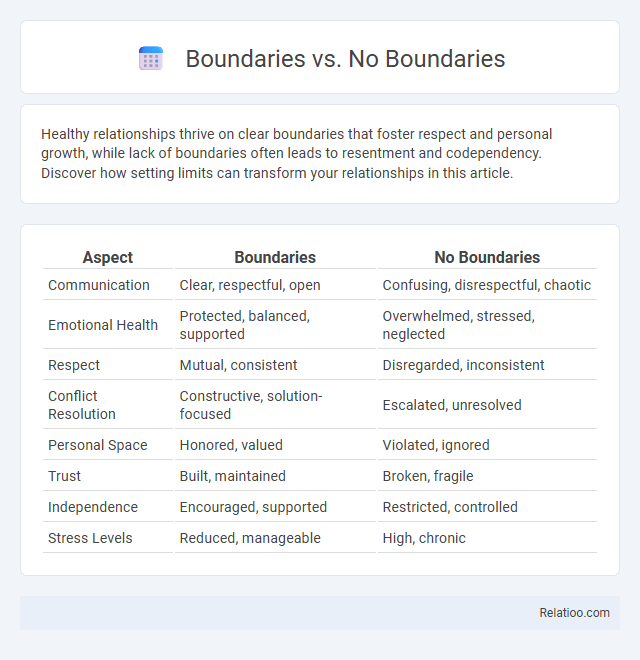Healthy relationships thrive on clear boundaries that foster respect and personal growth, while lack of boundaries often leads to resentment and codependency. Discover how setting limits can transform your relationships in this article.
Table of Comparison
| Aspect | Boundaries | No Boundaries |
|---|---|---|
| Communication | Clear, respectful, open | Confusing, disrespectful, chaotic |
| Emotional Health | Protected, balanced, supported | Overwhelmed, stressed, neglected |
| Respect | Mutual, consistent | Disregarded, inconsistent |
| Conflict Resolution | Constructive, solution-focused | Escalated, unresolved |
| Personal Space | Honored, valued | Violated, ignored |
| Trust | Built, maintained | Broken, fragile |
| Independence | Encouraged, supported | Restricted, controlled |
| Stress Levels | Reduced, manageable | High, chronic |
Understanding Boundaries: Definition and Importance
Understanding boundaries involves recognizing personal limits that protect your emotional and physical well-being. Clear boundaries define acceptable behavior, fostering healthy relationships and preventing dysfunction, while the absence of boundaries can lead to confusion, stress, and exploitation. Establishing and respecting boundaries is essential for your mental health and interpersonal harmony.
No Boundaries: What Does It Mean?
No boundaries indicate a lack of personal limits, resulting in difficulty saying no, allowing others to overstep, and often leading to emotional exhaustion and resentment. This absence can cause blurred roles in relationships, where the individual's needs and values are compromised or ignored. Understanding the impact of no boundaries is crucial to fostering healthy interactions and maintaining mental well-being.
The Psychological Benefits of Setting Boundaries
Setting clear personal boundaries fosters emotional resilience and enhances mental health by preventing burnout and reducing anxiety. In contrast, a lack of boundaries often leads to feelings of being overwhelmed and exploited, contributing to stress and dysfunctional relationships. Healthy boundary-setting promotes self-respect and improves interpersonal dynamics, crucial for psychological well-being.
Risks and Consequences of No Boundaries
No boundaries in relationships can lead to emotional exhaustion, loss of self-identity, and increased vulnerability to manipulation and abuse. Dysfunction often arises when personal limits are ignored, resulting in resentment, stress, and communication breakdowns. You risk long-term mental health issues and damaged relationships if you fail to establish and maintain clear boundaries.
Boundaries in Personal Relationships
Establishing clear boundaries in personal relationships enhances emotional well-being and fosters mutual respect by defining acceptable behavior and limits. Without boundaries, individuals risk emotional burnout, manipulation, or blurred identities that lead to dysfunction and unhealthy dependency. Healthy boundaries support autonomy and trust, while their absence often results in conflict, resentment, and impaired relationship dynamics.
Professional Life: Boundaries vs No Boundaries
Setting clear professional boundaries enhances productivity, reduces stress, and fosters respect among colleagues, enabling you to manage your workload effectively while maintaining work-life balance. Without boundaries, work can encroach on personal time, leading to burnout, decreased job satisfaction, and blurred roles that create confusion and conflict. Dysfunction arises when the absence of boundaries causes communication breakdowns, unrealistic expectations, and chronic stress that undermine both individual performance and team dynamics.
How to Establish Healthy Boundaries
Establishing healthy boundaries involves clearly defining personal limits while respecting others' needs and expectations to promote mutual understanding and emotional safety. No boundaries often lead to overcommitment and stress, whereas dysfunctional boundaries can cause codependency or conflict, highlighting the importance of consistent communication and self-awareness. Effective strategies include assertive communication, recognizing personal values, and practicing self-care to maintain balance in relationships.
Common Challenges When Setting Boundaries
Setting boundaries often involves challenges such as fear of rejection, guilt, and uncertainty about where to draw the line, which can lead to strained relationships or resentment. No boundaries typically result in emotional exhaustion, lack of self-respect, and vulnerability to manipulation or exploitation. Understanding these common obstacles helps you develop healthy limits that protect your well-being and improve interpersonal dynamics.
Signs of Unhealthy or Nonexistent Boundaries
Unhealthy or nonexistent boundaries manifest through signs such as constant people-pleasing, difficulty saying no, and feeling responsible for others' emotions, which often lead to emotional exhaustion and resentment. In relationships lacking boundaries, you may experience blurred lines between your needs and others', resulting in manipulation, codependency, or loss of self-identity. Recognizing these signs helps you protect your mental health and establish healthier, more balanced interactions.
Finding Balance: When to Flex or Hold Firm
Understanding the difference between boundaries, no boundaries, and dysfunction is essential for healthy relationships. Your ability to flex boundaries in safe situations while holding firm on non-negotiable limits fosters trust and respect. Striking this balance prevents emotional exhaustion and encourages personal growth without compromising your well-being.

Infographic: Boundaries vs No Boundaries
 relatioo.com
relatioo.com